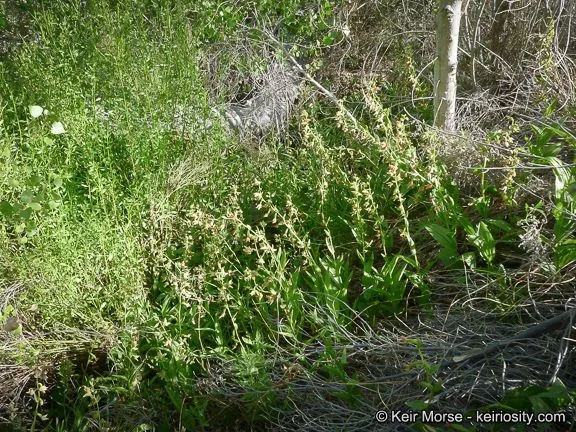
Author: Douglas ex Hook.
Bibliography: Fl. Bor.-Amer. 2: 202 (1839)
Year: 1839
Status: accepted
Rank: species
Genus: Epipactis
Vegetable: False
Observations: SW. Canada to N. Mexico
The Stream Orchid, scientifically known as Epipactis gigantea, is a captivating member of the Orchidaceae family. First documented in Flora Boreali-Americana volume 2 in 1839 by botanist David Douglas and later referenced by Sir William Jackson Hooker, this orchid has intrigued botanists and plant enthusiasts for centuries.
Epipactis gigantea thrives in a diverse range of environments stretching from Southwestern Canada all the way down to Northern Mexico. This geographical distribution highlights the plant’s adaptability and resilience across varying climates and terrains. The plant typically inhabits moist, riparian zones, often found along streams and wetlands, which is fitting given its common name, Stream Orchid.
The Stream Orchid is notable for its striking appearance. It features tall, slender stems, often reaching impressive heights, which is reflected in its species name “gigantea.” Along these stems, the plant produces alternating leaves that are green and lanceolate in shape. One of the most remarkable characteristics of this orchid is its flowers. The blooms are usually a captivating mix of greenish-yellow, often with a reddish or brownish hue, and are known for their complex and delicate structure, which is both visually stunning and biologically fascinating.
Ecologically, Epipactis gigantea plays a significant role in its habitat. It contributes to the biodiversity of wetland ecosystems and provides resources for a variety of pollinators, including bees and wasps, which are attracted to its nectar. The plant’s intricate flowers are specially adapted to facilitate effective pollination, ensuring the continuation of the species.
Efforts to study and conserve Epipactis gigantea are crucial given its ecological importance and the ongoing threats to its natural habitats due to human activities such as water management practices and habitat destruction. Cultivating awareness and appreciation for this exquisite orchid can aid in the preservation of not just the species but the delicate ecosystems it supports.
In summary, the Stream Orchid, Epipactis gigantea, is a beacon of botanical beauty and ecological significance that adorns the watery fringes of North America from Southwestern Canada to Northern Mexico. Its discovery and documentation in historical botanical literature underscore its enduring allure and the importance of its conservation for future generations to appreciate.
Eng: giant helleborine, stream orchid, chatterbox
Spa: heleborina gigante
Fra: épipactis géant
En: Stream orchid, Giant hellebore, Giant Helleborine, Chatterbox
Bg: Гигантски дремник
Fr: Épipactis géant
De: Amerikanische Ständelwurz, Amerikanische Stendelwurz
Nv: Chʼał nineezí bidą́ą́ʼ
Ru: Дремлик гигантский
Es: Heleborina gigante
Taken Jun 1, 2018 by Daniel Barthelemy (cc-by-nc)
Taken Jun 16, 2019 by huy HO (cc-by-sa)
Taken Jun 1, 2018 by Daniel Barthelemy (cc-by-nc)
Taken Nov 11, 2014 by EOL − Keir Morse (cc-by-nc-sa)
Taken Nov 27, 2009 by EOL − Gary A. Monroe (cc-by-nc)
Taken Aug 18, 2005 by EOL − J. E.(Jed) and Bonnie McClellan (cc-by-nc-sa)
Taken Jan 1, 1900 by EOL − Cooper, G.A. (cc-by-nc-sa)
Taken Jan 1, 1900 by EOL − Cooper, G.A. (cc-by-nc-sa)
Taken Jan 1, 1900 by EOL − Cooper, G.A. (cc-by-nc-sa)
Taken Jan 1, 1900 by EOL − Cooper, G.A. (cc-by-nc-sa)
Taken Jan 1, 1900 by EOL − Cooper, G.A. (cc-by-nc-sa)
Taken Nov 13, 2002 by EOL − Gerald and Buff Corsi (cc-by-nc-sa)
Taken Feb 3, 2014 by EOL − Richard Reynolds (cc-by-nc)
Taken Jun 12, 2018 by Sandy Rowley (cc-by-sa)
Taken Jun 12, 2018 by Sandy Rowley (cc-by-sa)
© copyright of the Board of Trustees of the Royal Botanic Gardens, Kew.
Growth habit>: Forb/herb
Family: Myrtaceae Author: (F.Muell.) K.D.Hill & L.A.S.Johnson Bibliography: Telopea 6: 402 (1995) Year: 1995 Status:…
Family: Rubiaceae Author: Pierre ex A.Froehner Bibliography: Notizbl. Bot. Gart. Berlin-Dahlem 1: 237 (1897) Year:…
Family: Sapindaceae Author: Koidz. Bibliography: J. Coll. Sci. Imp. Univ. Tokyo 32(1): 38 (1911) Year:…
Family: Asteraceae Author: A.Gray Bibliography: Pacif. Railr. Rep.: 107 (1857) Year: 1857 Status: accepted Rank:…
Family: Fabaceae Author: Medik. Bibliography: Vorles. Churpfälz. Phys.-Ökon. Ges. 2: 398 (1787) Year: 1787 Status:…
Family: Aspleniaceae Author: (Cav.) Alston Bibliography: Bull. Misc. Inform. Kew 1932: 309 (1932) Year: 1932…